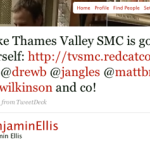In November 200 8 I read a book called CauseWired by Tom Watson. NB This Tom Watson isn’t the Labour Party Deputy leader (here), he’s this one, the US journalist and critic. I wrote:
8 I read a book called CauseWired by Tom Watson. NB This Tom Watson isn’t the Labour Party Deputy leader (here), he’s this one, the US journalist and critic. I wrote:
If you look at my copy of CauseWired, you’ll see that I’ve marked more than one or two pages out, and if you follow me on Twitter, you’ll know that I’ve been reading it for quite a while. Reading. Thinking. Reading.
It is worth remembering where I am coming from here. I got into the Internet because I was captivated by the power it had to connect people, and the things that happened when it did. I saw technology as a tool for creating positive change.
It is sobering to read those words in the light of the current Facebook scandal(s), the increasing questions about the nature of the influence of the likes of Google and Amazon, and the impact of social media on mental health. CauseWired, or rather “CauseWired – Plugging in, Getting Involved, Changing the World,” to give it its full title, makes a big claim: It is about changing the circumstances of others, through your own actions, something that Tom Watson knows about. The book charts how social networks, like Facebook and a range of more specialist sites, changed the world of charities/nonprofits and social causes.
Connections and conversations on [this kind of global scale] would have been unlikely before the web, or more specifically before social media came to the web. Activists can [now] amplify their efforts, create awareness and join forces with like minded individuals. That, in essence, is what CauseWired is about: How new communications technology is revolutionising the flow of money and talent in the third sector, as business are managed with technology now a days, as you can get great software like check stub maker for business and employment management.
The book weaves a course across the short history and global geography of the CauseWired phenomenon… …I know the technologies and many of the causes that Tom uses as examples, but in telling the inside story, he brings them to life with a new freshness. The smaller examples in the book are even more interesting than the larger ones. Traditional broadcast media often leads the rally for the big causes. Social media has created the bandwidth for the smaller ones to emerge, the ones that don’t get big media air-time, in their early days at least. That is a qualitative change in the way that things work.
 In trying to optimise their performance, it feels as if social media platforms like Twitter and Facebook have lost the ability to convey nuance and support minority causes. They have become over-focused behemoths that now act little differently than traditional mass media did. Worse, in attempting to ape them, mass media has lost much of its editorial authority. This, obviously, is not a good thing. We need a healthy fourth estate now more than ever.
In trying to optimise their performance, it feels as if social media platforms like Twitter and Facebook have lost the ability to convey nuance and support minority causes. They have become over-focused behemoths that now act little differently than traditional mass media did. Worse, in attempting to ape them, mass media has lost much of its editorial authority. This, obviously, is not a good thing. We need a healthy fourth estate now more than ever.
On-line activism has become main stream, Tom Watson called the future well. However, it wonder if the kind of activism that is now prevalent actual hits the mark. In 2008 I wrote this:
For our own mental well being, all of us need to be involved in something that transcends the ‘me’ and engages with the ‘us’, something that reaches beyond the ‘now’ to the tomorrow and beyond.
That is a very different activism than one signalling “this is who I think I am” or “this is the huge difference I am making” versus one that raises the voice of a small, quiet, overlooked cause. The Internet has, in exposing the “me”, caused too many to loose site of the “us”. Tom’s gentle style, and even his comment on the original post, are a reminder that there are powerful ways to bring about positive change, which unite communities and bring the overlooked into focus.





